ASTEPRO
-
azelastine hydrochloride spray, metered
Meda Pharmaceuticals Inc.
----------
|
|||||||||||||||||||
FULL PRESCRIBING INFORMATION
1 INDICATIONS AND USAGE
1.1 Allergic Rhinitis
ASTEPRO Nasal Spray 0.1% and 0.15% is indicated for the relief of the symptoms of seasonal and perennial allergic rhinitis in patients 12 years of age and older.
2 DOSAGE AND ADMINISTRATION
2.1 Seasonal Allergic Rhinitis
The recommended dose of ASTEPRO Nasal Spray 0.1% and 0.15% is 1 or 2 sprays per nostril twice daily for seasonal allergic rhinitis. ASTEPRO Nasal Spray 0.15% may also be administered as 2 sprays per nostril once daily.
2.2 Perennial Allergic Rhinitis
The recommended dose of ASTEPRO Nasal Spray 0.15% for perennial allergic rhinitis is 2 sprays per nostril twice daily.
2.3 Important Administration Instructions
Administer ASTEPRO Nasal Spray by the intranasal route only.
Priming: Prime ASTEPRO Nasal Spray before initial use by releasing 6 sprays or until a fine mist appears. When ASTEPRO Nasal Spray has not been used for 3 or more days, reprime with 2 sprays or until a fine mist appears. Avoid spraying ASTEPRO Nasal Spray into the eyes.
3 DOSAGE FORMS AND STRENGTHS
ASTEPRO Nasal Spray is a nasal spray solution. Each spray of ASTEPRO Nasal Spray 0.1% delivers a volume of 0.137 mL solution containing 137 mcg of azelastine hydrochloride. Each spray of ASTEPRO Nasal Spray 0.15% delivers a volume of 0.137 mL solution containing 205.5 mcg of azelastine hydrochloride.
4 CONTRAINDICATIONS
None.
5 WARNINGS AND PRECAUTIONS
5.1 Activities Requiring Mental Alertness
In clinical trials, the occurrence of somnolence has been reported in some patients taking ASTEPRO Nasal Spray [see Adverse Reactions (6.1)]. Patients should be cautioned against engaging in hazardous occupations requiring complete mental alertness and motor coordination such as operating machinery or driving a motor vehicle after administration of ASTEPRO Nasal Spray. Concurrent use of ASTEPRO Nasal Spray with alcohol or other central nervous system depressants should be avoided because additional reductions in alertness and additional impairment of central nervous system performance may occur [see Drug Interactions (7.1)].
6 ADVERSE REACTIONS
Use of ASTEPRO Nasal Spray has been associated with somnolence [see Warnings and Precautions (5.1)].
6.1 Clinical Trials Experience
Because clinical trials are conducted under widely varying conditions, adverse reaction rates observed in clinical trials of a drug cannot be directly compared to rates in the clinical trials of another drug and may not reflect rates observed in practice.
ASTEPRO Nasal Spray 0.1%
The safety data described below reflect exposure to ASTEPRO Nasal Spray 0.1% in 713 patients 12 years of age and older from 2 clinical trials of 2 weeks to 12 months duration. In a 2-week, double-blind, placebo-controlled, and active-controlled (Astelin® Nasal Spray; azelastine hydrochloride) clinical trial, 285 patients (115 males and 170 females) 12 years of age and older with seasonal allergic rhinitis were treated with ASTEPRO Nasal Spray 0.1% one or two sprays per nostril daily. In the 12 month open-label, active-controlled (Astelin Nasal Spray) clinical trial, 428 patients (207 males and 221 females) 12 years of age and older with perennial allergic rhinitis and/or nonallergic rhinitis were treated with ASTEPRO Nasal Spray 0.1% two sprays per nostril twice daily. The racial and ethnic distribution for the 2 clinical trials was 82% white, 8% black, 6% Hispanic, 3% Asian, and <1% other.
Adults and Adolescents 12 Years of Age and Older
In the two week clinical trial, 835 patients 12 years of age and older with seasonal allergic rhinitis were treated with one of six treatments: one spray per nostril of either ASTEPRO Nasal Spray 0.1%, Astelin Nasal Spray or placebo twice daily; or 2 sprays per nostril of ASTEPRO Nasal Spray 0.1%, Astelin Nasal Spray, or placebo twice daily. Overall, adverse reactions were more common in the ASTEPRO Nasal Spray 0.1% treatment groups (21-28%) than in the placebo groups (16-20%). Overall, less than 1% of patients discontinued due to adverse reactions and withdrawal due to adverse reactions was similar among the treatment groups.
Table 1 contains adverse reactions reported with frequencies greater than or equal to 2% and more frequently than placebo in patients treated with ASTEPRO Nasal Spray 0.1% in the controlled clinical trial described above.
| 1 spray twice daily | 2 sprays twice daily | |||||
| ASTEPRO Nasal Spray 0.1% (N=139) | Astelin Nasal Spray (N=137) | Vehicle Placebo (N=137) | ASTEPRO Nasal Spray 0.1% (N=146) | Astelin Nasal Spray (N=137) | Vehicle Placebo (N=138) |
|
| Bitter Taste | 8 (6%) | 13 (10%) | 2 (2%) | 10 (7%) | 11 (8%) | 3 (2%) |
| Epistaxis | 3 (2%) | 8 (6%) | 3 (2%) | 4 (3%) | 3 (2%) | 0 (0%) |
| Headache | 2 (1%) | 5 (4%) | 1 (<1%) | 4 (3%) | 3 (2%) | 1 (<1%) |
| Nasal Discomfort | 0 (0%) | 3 (2%) | 1 (<1%) | 2 (1%) | 6 (4%) | 0 (0%) |
| Fatigue | 0 (0%) | 1 (<1%) | 1 (<1%) | 3 (2%) | 3 (2%) | 1 (<1%) |
| Somnolence | 2 (1%) | 2 (2%) | 0 (0%) | 3 (2%) | 2 (1%) | 0 (0%) |
Long-Term (12 Month) Safety Trial:
In the 12 month, open-label, active-controlled, long-term safety trial, 862 patients 12 years of age and older with perennial allergic and/or nonallergic rhinitis were treated with ASTEPRO Nasal Spray 0.1% two sprays per nostril twice daily or Astelin Nasal Spray two sprays per nostril twice daily. The most frequently reported adverse reactions were headache, bitter taste, epistaxis, and nasopharyngitis and were generally similar between treatment groups. Focused nasal examinations were performed and showed that the incidence of nasal mucosal ulceration in each treatment group was approximately 1% at baseline and approximately 1.5% throughout the 12 month treatment period. In each treatment group, 5-7% of patients had mild epistaxis. No patients had reports of nasal septal perforation or severe epistaxis. Twenty-two patients (5%) treated with ASTEPRO Nasal Spray 0.1% and 17 patients (4%) treated with Astelin Nasal Spray discontinued from the trial due to adverse events.
ASTEPRO Nasal Spray 0.15%
The safety data described below reflect exposure to ASTEPRO Nasal Spray 0.15% in 1858 patients (12 years of age and older) with seasonal or perennial allergic rhinitis from 8 clinical trials of 2 weeks to 12 months duration. In 7 double-blind, placebo-controlled clinical trials of 2 to 4 weeks duration, 1544 patients (560 males and 984 females) with seasonal or perennial allergic rhinitis were treated with ASTEPRO Nasal Spray 0.15% two sprays per nostril once or twice daily. In the 12 month open-label, active-controlled clinical trial, 466 patients (156 males and 310 females) with perennial allergic rhinitis were treated with ASTEPRO Nasal Spray 0.15% two sprays per nostril twice daily. Of these 466 patients, 152 had participated in the 4-week placebo-controlled perennial allergic rhinitis clinical trials. The racial distribution for the 8 clinical trials was 80% white, 13% black, 2% Asian, and 5% other.
Adults and Adolescents 12 Years of Age and Older
In the 7 placebo controlled clinical trials of 2 to 4 week duration, 2343 patients with seasonal allergic rhinitis and 540 patients with perennial allergic rhinitis were treated with two sprays per nostril of either ASTEPRO Nasal Spray 0.15% or placebo once or twice daily. Overall, adverse reactions were more common in the ASTEPRO Nasal Spray 0.15% treatment groups (16-31%) than in the placebo groups (11-24%). Overall, less than 2% of patients discontinued due to adverse reactions and withdrawal due to adverse reactions was similar among the treatment groups.
Table 2 contains adverse reactions reported with frequencies greater than or equal to 2% and more frequently than placebo in patients treated with ASTEPRO Nasal Spray 0.15% in the seasonal and perennial allergic rhinitis controlled clinical trials.
| 2 sprays twice daily | 2 sprays once daily | |||
| ASTEPRO Nasal Spray 0.15% (N=523) | Vehicle Placebo (N=523) | ASTEPRO Nasal Spray 0.15% (N=1021) | Vehicle Placebo (N=816) |
|
| Bitter Taste | 31 (6%) | 5 (1%) | 38 (4%) | 2 (<1%) |
| Nasal Discomfort | 18 (3%) | 12 (2%) | 37 (4%) | 7 (1%) |
| Epistaxis | 5 (1%) | 7 (1%) | 21 (2%) | 14 (2%) |
| Sneezing | 9 (2%) | 1 (<1%) | 14 (1%) | 0 (0%) |
In the above trials, somnolence was reported in <1% of patients treated with ASTEPRO Nasal Spray 0.15% (11 of 1544) or vehicle placebo (1 of 1339).
Long-Term (12 Month) Safety Trial:
In the 12 month, open-label, active-controlled, long-term safety trial, 466 patients (12 years of age and older) with perennial allergic rhinitis were treated with ASTEPRO Nasal Spray 0.15% two sprays per nostril twice daily and 237 patients were treated with mometasone nasal spray two sprays per nostril once daily. The most frequently reported adverse reactions (>5%) with ASTEPRO Nasal Spray 0.15% were bitter taste, headache, sinusitis, and epistaxis. Focused nasal examinations were performed and no nasal ulcerations or septal perforations were observed. In each treatment group, approximately 3% of patients had mild epistaxis. No patients had reports of severe epistaxis. Fifty-four patients (12%) treated with ASTEPRO Nasal Spray 0.15% and 17 patients (7%) treated with mometasone nasal spray discontinued from the trial due to adverse events.
6.2 Postmarketing Experience
The following adverse reactions have been identified during the post approval use of the Astelin brand of azelastine hydrochloride 0.1% nasal spray (total daily dose 0.55 mg to 1.1 mg). Because these reactions are reported voluntarily from a population of uncertain size, it is not always possible to reliably estimate their frequency or establish a causal relationship to drug exposure. Adverse reactions reported include the following: anaphylactoid reaction, application site irritation, atrial fibrillation, blurred vision, chest pain, confusion, dizziness, dyspnea, facial edema, hypertension, involuntary muscle contractions, nervousness, palpitations, paresthesia, parosmia, paroxysmal sneezing, pruritus, rash, disturbance or loss of sense of smell and/or taste, tachycardia, tolerance, urinary retention, and xerophthalmia.
7 DRUG INTERACTIONS
7.1 Central Nervous System Depressants
Concurrent use of ASTEPRO Nasal Spray with alcohol or other central nervous system depressants should be avoided because reductions in alertness and impairment of central nervous system performance may occur [see Warnings and Precautions (5.1)].
7.2 Erythromycin and Ketoconazole
Interaction studies investigating the cardiac effects, as measured by the corrected QT interval (QTc), of concomitantly administered oral azelastine hydrochloride and erythromycin or ketoconazole were conducted. Oral erythromycin (500 mg three times daily for 7 days) had no effect on azelastine pharmacokinetics or QTc based on analyses of serial electrocardiograms. Ketoconazole (200 mg twice daily for 7 days) interfered with the measurement of azelastine plasma concentrations on the analytic HPLC; however, no effects on QTc were observed [see Clinical Pharmacology (12.2) and (12.3)].
7.3 Cimetidine
Cimetidine (400 mg twice daily) increased the mean Cmax and AUC of orally administered azelastine hydrochloride (4 mg twice daily) by approximately 65% [see Clinical Pharmacology (12.3)].
8 USE IN SPECIFIC POPULATIONS
8.1 Pregnancy
Pregnancy Category C: There are no adequate and well-controlled clinical trials in pregnant women. Azelastine hydrochloride has been shown to cause developmental toxicity in mice, rats, and rabbits. ASTEPRO Nasal Spray should be used during pregnancy only if the potential benefit justifies the potential risk to the fetus.
Teratogenic Effects: In mice, azelastine hydrochloride caused embryo-fetal death, malformations (cleft palate; short or absent tail; fused, absent or branched ribs), delayed ossification, and decreased fetal weight at an oral dose approximately 170 times the maximum recommended human daily intranasal dose (MRHDID) in adults on a mg/m2 basis. This dose also caused maternal toxicity as evidenced by decreased body weight. Neither fetal nor maternal effects occurred at a dose that was approximately 7 times the MRHDID.
In rats, azelastine hydrochloride caused malformations (oligo- and brachydactylia), delayed ossification and skeletal variations, in the absence of maternal toxicity, at an oral dose approximately 150 times the MRHDID in adults on a mg/m2 basis. At a dose approximately 340 times the MRHDID, azelastine hydrochloride also caused embryo-fetal death and decreased fetal weight; however, this dose caused severe maternal toxicity. Neither fetal nor maternal effects occurred at a dose approximately 15 times the MRHDID.
In rabbits, azelastine hydrochloride caused abortion, delayed ossification and decreased fetal weight at oral doses approximately 300 times the MRHDID in adults on a mg/m2 basis; however, these doses also resulted in severe maternal toxicity. Neither fetal nor maternal effects occurred at a dose approximately 3 times the MRHDID.
8.3 Nursing Mothers
It is not known whether azelastine hydrochloride is excreted in human milk. Because many drugs are excreted in human milk, caution should be exercised when ASTEPRO Nasal Spray is administered to a nursing woman.
8.4 Pediatric Use
Safety and effectiveness of ASTEPRO Nasal Spray in pediatric patients below the age of 12 years have not been established.
8.5 Geriatric Use
Clinical trials of ASTEPRO Nasal Spray did not include sufficient numbers of patients 65 years of age and older to determine whether they respond differently from younger patients. Other reported clinical experience has not identified differences in responses between the elderly and younger patients. In general, dose selection for an elderly patient should be cautious, usually starting at the low end of the dosing range, reflecting the greater frequency of decreased hepatic, renal, or cardiac function, and of concomitant disease or other drug therapy.
10 OVERDOSAGE
There have been no reported overdosages with ASTEPRO Nasal Spray. Acute overdosage by adults with this dosage form is unlikely to result in clinically significant adverse events, other than increased somnolence, since one 30-mL bottle of ASTEPRO Nasal Spray 0.1% contains up to 30 mg of azelastine hydrochloride and one 30-mL bottle of ASTEPRO Nasal Spray 0.15% contains up to 45 mg of azelastine hydrochloride. Clinical trials in adults with single doses of the oral formulation of azelastine hydrochloride (up to 16 mg) have not resulted in increased incidence of serious adverse events. General supportive measures should be employed if overdosage occurs. There is no known antidote to ASTEPRO Nasal Spray. Oral ingestion of antihistamines has the potential to cause serious adverse effects in children. Accordingly, ASTEPRO Nasal Spray should be kept out of the reach of children. Oral doses of 120 mg/kg and greater (approximately 300 times the maximum recommended human daily intranasal dose [MRHDID] in adults and children on a mg/m2 basis) were lethal in mice. Responses seen prior to death were tremor, convulsions, decreased muscle tone, and salivation. In dogs, single oral doses as high as 10 mg/kg (approximately 160 times the MRHDID in adults and children on a mg/m2 basis) were well tolerated, but single oral doses of 20 mg/kg were lethal.
11 DESCRIPTION
ASTEPRO (azelastine hydrochloride) Nasal Spray 0.1%, 137 micrograms (mcg), is an antihistamine formulated as a metered-spray solution for intranasal administration. ASTEPRO (azelastine hydrochloride) Nasal Spray 0.15%, 205.5 micrograms (mcg), is formulated as a metered-spray solution for intranasal administration.
Azelastine hydrochloride occurs as a white, almost odorless, crystalline powder with a bitter taste. It has a molecular weight of 418.37. It is sparingly soluble in water, methanol, and propylene glycol and slightly soluble in ethanol, octanol, and glycerine. It has a melting point of about 225°C and the pH of a saturated solution is between 5.0 and 5.4. Its chemical name is (±)-1-(2H)-phthalazinone,4-[(4-chlorophenyl) methyl]-2-(hexahydro-1-methyl-1H-azepin-4-yl)-, monohydrochloride. Its molecular formula is C22H24ClN3O•HCl with the following chemical structure:
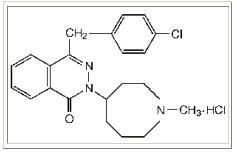
ASTEPRO Nasal Spray 0.1% contains 0.1% azelastine hydrochloride in an isotonic aqueous solution containing sorbitol, sucralose, hypromellose, sodium citrate, edetate disodium, benzalkonium chloride (125 mcg/mL), and purified water (pH 6.4).
After priming [see Dosage and Administration (2.3)], each metered spray delivers a 0.137 mL mean volume containing 137 mcg of azelastine hydrochloride (equivalent to 125 mcg of azelastine base). The 30-mL (net weight 30 gm of solution) bottle provides 200 metered sprays.
ASTEPRO Nasal Spray 0.15% contains 0.15% azelastine hydrochloride in an isotonic aqueous solution containing sorbitol, sucralose, hypromellose, sodium citrate, edetate disodium, benzalkonium chloride (125 mcg/mL), and purified water (pH 6.4).
After priming [see Dosage and Administration (2.3)], each metered spray delivers a 0.137 mL mean volume containing 205.5 mcg of azelastine hydrochloride (equivalent to 187.6 mcg of azelastine base). The 30-mL (net weight 30 gm of solution) bottle provides 200 metered sprays.
12 CLINICAL PHARMACOLOGY
12.1 Mechanism of Action
Azelastine hydrochloride, a phthalazinone derivative, exhibits histamine H1 -receptor antagonist activity in isolated tissues, animal models, and humans. ASTEPRO Nasal Spray is administered as a racemic mixture with no difference in pharmacologic activity noted between the enantiomers in in vitro studies. The major metabolite, desmethylazelastine, also possesses H1 -receptor antagonist activity.
12.2 Pharmacodynamics
Cardiac Effects:
In a placebo-controlled trial (95 patients with allergic rhinitis), there was no evidence of an effect of azelastine hydrochloride nasal spray (2 sprays per nostril twice daily for 56 days) on cardiac repolarization as represented by the corrected QT interval (QTc) of the electrocardiogram. Following multiple dose oral administration of azelastine 4 mg or 8 mg twice daily, the mean change in QTc was 7.2 msec and 3.6 msec, respectively.
Interaction studies investigating the cardiac repolarization effects of concomitantly administered oral azelastine hydrochloride and erythromycin or ketoconazole were conducted. Oral erythromycin had no effect on azelastine pharmacokinetics or QTc based on analysis of serial electrocardiograms. Ketoconazole interfered with the measurement of azelastine plasma levels; however, no effects on QTc were observed [see Drug Interactions (7.2)].
12.3 Pharmacokinetics
Absorption: After intranasal administration of 2 sprays per nostril (548 mcg total dose) of ASTEPRO Nasal Spray 0.1%, the mean azelastine peak plasma concentration (Cmax) is 200 pg/mL, the mean extent of systemic exposure (AUC) is 5122 pg•hr/mL and the median time to reach Cmax (tmax) is 3 hours. After intranasal administration of 2 sprays per nostril (822 mcg total dose) of ASTEPRO Nasal Spray 0.15%, the mean azelastine peak plasma concentration (Cmax) is 409 pg/mL, the mean extent of systemic exposure (AUC) is 9312 pg•hr/mL and the median time to reach Cmax (tmax) is 4 hours. The systemic bioavailability of azelastine hydrochloride is approximately 40% after intranasal administration.
Distribution: Based on intravenous and oral administration, the steady-state volume of distribution of azelastine is 14.5 L/kg. In vitro studies with human plasma indicate that the plasma protein binding of azelastine and its metabolite, desmethylazelastine, are approximately 88% and 97%, respectively.
Metabolism: Azelastine is oxidatively metabolized to the principal active metabolite, desmethylazelastine, by the cytochrome P450 enzyme system. The specific P450 isoforms responsible for the biotransformation of azelastine have not been identified. After a single-dose, intranasal administration of ASTEPRO Nasal Spray 0.1% (548 mcg total dose), the mean desmethylazelastine Cmax is 23 pg/mL, the AUC is 2131 pg•hr/mL and the median tmax is 24 hours. After a single-dose, intranasal administration of ASTEPRO Nasal Spray 0.15% (822 mcg total dose), the mean desmethylazelastine Cmax is 38 pg/mL, the AUC is 3824 pg•hr/mL and the median tmax is 24 hours. After intranasal dosing of azelastine to steady-state, plasma concentrations of desmethylazelastine range from 20-50% of azelastine concentrations.
Elimination: Following intranasal administration of ASTEPRO Nasal Spray 0.1%, the elimination half-life of azelastine is 22 hours while that of desmethylazelastine is 52 hours. Following intranasal administration of ASTEPRO Nasal Spray 0.15%, the elimination half-life of azelastine is 25 hours while that of desmethylazelastine is 57 hours. Approximately 75% of an oral dose of radiolabeled azelastine hydrochloride was excreted in the feces with less than 10% as unchanged azelastine.
Special Populations:
Hepatic Impairment: Following oral administration, pharmacokinetic parameters were not influenced by hepatic impairment.
Renal Impairment: Based on oral, single-dose studies, renal insufficiency (creatinine clearance <50 mL/min) resulted in a 70-75% higher Cmax and AUC compared to healthy subjects. Time to maximum concentration was unchanged.
Age: Following oral administration, pharmacokinetic parameters were not influenced by age.
Gender: Following oral administration, pharmacokinetic parameters were not influenced by gender.
Race: The effect of race has not been evaluated.
Drug-Drug Interactions:
Erythromycin: Co-administration of orally administered azelastine (4 mg twice daily) with erythromycin (500 mg three times daily for 7 days) resulted in Cmax of 5.36 ± 2.6 ng/mL and AUC of 49.7 ± 24 ng•h/mL for azelastine, whereas, administration of azelastine alone resulted in Cmax of 5.57 ± 2.7 ng/mL and AUC of 48.4 ± 24 ng•h/mL for azelastine [see Drug Interactions (7.2)].
Cimetidine and Ranitidine: In a multiple-dose, steady-state drug interaction trial in healthy subjects, cimetidine (400 mg twice daily) increased orally administered mean azelastine (4 mg twice daily) concentrations by approximately 65%. Co-administration of orally administered azelastine (4 mg twice daily) with ranitidine hydrochloride (150 mg twice daily) resulted in Cmax of 8.89 ±3.28 ng/mL and AUC of 88.22 ± 40.43 ng•h/mL for azelastine, whereas, administration of azelastine alone resulted in Cmax of 7.83 ±± 4.06 ng/mL and AUC of 80.09 ± 43.55 ng•h/mL for azelastine [see Drug Interactions (7.3)].
Theophylline: No significant pharmacokinetic interaction was observed with the co-administration of an oral 4 mg dose of azelastine hydrochloride twice daily and theophylline 300 mg or 400 mg twice daily.
13 NONCLINICAL TOXICOLOGY
13.1 Carcinogenesis, Mutagenesis, Impairment of Fertility
In 2-year carcinogenicity studies in rats and mice, azelastine hydrochloride did not show evidence of carcinogenicity at oral doses up to 30 mg/kg and 25 mg/kg, respectively. These doses were approximately 150 and 60 times the maximum recommended human daily intranasal dose [MRHDID] on a mg/m2 basis.
Azelastine hydrochloride showed no genotoxic effects in the Ames test, DNA repair test, mouse lymphoma forward mutation assay, mouse micronucleus test, or chromosomal aberration test in rat bone marrow.
Reproduction and fertility studies in rats showed no effects on male or female fertility at oral doses up to 30 mg/kg (approximately 150 times the MRHDID in adults on a mg/m2 basis). At 68.6 mg/kg (approximately 340 times the MRHDID on a mg/m2 basis), the duration of estrous cycles was prolonged and copulatory activity and the number of pregnancies were decreased. The numbers of corpora lutea and implantations were decreased; however, pre-implantation loss was not increased.
13.2 Animal Toxicology and/or Pharmacology
Reproductive Toxicology Studies
Azelastine hydrochloride has been shown to cause developmental toxicity. Treatment of mice with an oral dose of 68.6 mg/kg (approximately 170 times the maximum recommended human daily intranasal dose [MRHDID] on a mg/m2 basis) caused embryo-fetal death, malformations (cleft palate; short or absent tail; fused, absent or branched ribs), delayed ossification, and decreased fetal weight. This dose also caused maternal toxicity as evidenced by decreased body weight. Neither fetal nor maternal effects occurred at a dose of 3 mg/kg (approximately 7 times the MRHDID on a mg/m2 basis).
In rats, an oral dose of 30 mg/kg (approximately 150 times the MRHDID on a mg/m2 basis) caused malformations (oligo-and brachydactylia), delayed ossification and skeletal variations, in the absence of maternal toxicity. At 68.6 mg/kg (approximately 340 times the MRHDID on a mg/m2 basis) azelastine hydrochloride also caused embryo-fetal death and decreased fetal weight; however, the 68.6 mg/kg dose caused severe maternal toxicity. Neither fetal nor maternal effects occurred at a dose of 3 mg/kg (approximately 15 times the MRHDID on a mg/m2 basis).
In rabbits, oral doses of 30 mg/kg and greater (approximately 300 times the MRHDID on a mg/m2 basis) caused abortion, delayed ossification and decreased fetal weight; however, these doses also resulted in severe maternal toxicity. Neither fetal nor maternal effects occurred at a dose of 0.3 mg/kg (approximately 3 times the MRHDID on a mg/m2 basis).
14 CLINICAL STUDIES
14.1 Seasonal Allergic Rhinitis
ASTEPRO Nasal Spray 0.1%
The efficacy and safety of ASTEPRO Nasal Spray 0.1% was evaluated in a 2-week, randomized, multicenter, double-blind, placebo-controlled clinical trial including 834 adult and adolescent patients 12 years of age and older with symptoms of seasonal allergic rhinitis. The population was 12 to 83 years of age (60% female, 40% male; 69% white, 16% black, 12% Hispanic, 2% Asian, 1% other).
Patients were randomized to one of six treatment groups: 1 spray per nostril of either ASTEPRO Nasal Spray 0.1%, Astelin (azelastine hydrochloride) Nasal Spray or vehicle placebo twice daily; or 2 sprays per nostril of ASTEPRO Nasal Spray 0.1%, Astelin (azelastine hydrochloride) Nasal Spray or vehicle placebo twice daily.
Assessment of efficacy was based on the 12-hour reflective total nasal symptom score (rTNSS) assessed daily in the morning and evening, in addition to the instantaneous total nasal symptom score (iTNSS) and other supportive secondary efficacy variables. TNSS is calculated as the sum of the patients’ scoring of the four individual nasal symptoms (rhinorrhea, nasal congestion, sneezing, and nasal itching) on a 0 to 3 categorical severity scale (0 = absent, 1 = mild, 2 = moderate, 3 = severe). The rTNSS required patients to record symptom severity over the previous 12 hours. For the primary efficacy endpoint, the mean change from baseline rTNSS, morning (AM) and evening (PM) rTNSS scores were summed for each day (maximum score of 24) and then averaged over the 2 weeks. The iTNSS, recorded immediately prior to the next dose, were assessed as an indication of whether the effect was maintained over the dosing interval.
In this trial, ASTEPRO Nasal Spray 0.1% two sprays twice a day demonstrated a greater decrease in rTNSS and iTNSS than placebo and the difference was statistically significant. The trial results are presented in Table 3 (Trial 1).
The efficacy of ASTEPRO Nasal Spray 0.1% one spray per nostril twice daily for seasonal allergic rhinitis is supported by two, 2-week, placebo-controlled clinical trials with Astelin (azelastine hydrochloride) Nasal Spray in 413 patients with seasonal allergic rhinitis. In these trials, efficacy was assessed using the TNSS (described above). Astelin Nasal Spray demonstrated a greater decrease from baseline in the summed AM and PM rTNSS compared with placebo and the difference was statistically significant.
ASTEPRO Nasal Spray 0.15%
The efficacy and safety of ASTEPRO Nasal Spray 0.15% in seasonal allergic rhinitis was evaluated in five randomized, multicenter, double-blind, placebo-controlled clinical trials in 2499 adult and adolescent patients 12 years and older with symptoms of seasonal allergic rhinitis (Trials 2, 3, 4, 5, and 6). The population of the trials was 12 to 83 years of age (64% female, 36% male; 81% white, 12% black, <2% Asian, 5% other; 23% Hispanic, 77% non-Hispanic). Assessment of efficacy was based on the rTNSS, iTNSS as described above, and other supportive secondary efficacy variables. The primary efficacy endpoint was the mean change from baseline in rTNSS over 2 weeks.
Two 2-week seasonal allergic rhinitis trials evaluated the efficacy of ASTEPRO Nasal Spray 0.15% dosed at 2 sprays twice daily. The first trial (Trial 2) compared the efficacy of ASTEPRO Nasal Spray 0.15% and Astelin (azelastine hydrochloride) Nasal Spray to vehicle placebo. The other trial (Trial 3) compared the efficacy of ASTEPRO Nasal Spray 0.15% and ASTEPRO Nasal Spray 0.1% to vehicle placebo. In these two trials, ASTEPRO Nasal Spray 0.15% demonstrated greater decreases in rTNSS than placebo and the differences were statistically significant (Table 3).
Three 2-week seasonal allergic rhinitis trials evaluated the efficacy of ASTEPRO Nasal Spray 0.15% dosed at 2 sprays once daily compared to the vehicle placebo. Trial 4 demonstrated a greater decrease in rTNSS than placebo and the difference was statistically significant (Table 3). Trial 5 and Trial 6 were conducted in patients with Texas mountain cedar allergy. In Trial 5 and Trial 6, ASTEPRO Nasal Spray 0.15% demonstrated a greater decrease in rTNSS than placebo and the differences were statistically significant (Trials 5 and 6; Table 3). Instantaneous TNSS results for the once daily dosing regimen of ASTEPRO Nasal Spray 0.15% are shown in Table 4. In Trials 5 and 6, ASTEPRO Nasal Spray 0.15% demonstrated a greater decrease in iTNSS than placebo and the differences were statistically significant.
| *Sum of AM and PM rTNSS for each day (Maximum score=24) and averaged over the 14 day treatment period | |||||||
| Treatment (sprays per nostril) | n | Baseline LS Mean | Change from Baseline | Difference From Placebo | |||
| LS Mean | 95% CI | P value | |||||
| Trial 1 | |||||||
| Two sprays twice daily | ASTEPRO Nasal Spray 0.1% | 146 | 18.0 | -5.0 | -2.2 | -3.2,-1.2 | <0.001 |
| Astelin Nasal Spray | 137 | 18.2 | -4.2 | -1.4 | -2.4,-0.4 | 0.01 | |
| Vehicle Placebo | 138 | 18.2 | -2.8 | ||||
| One spray twice daily | ASTEPRO Nasal Spray 0.1% | 139 | 18.2 | -4.2 | -0.7 | -1.7, 0.3 | 0.18 |
| Astelin Nasal Spray | 137 | 18.1 | -4.0 | -0.4 | -1.5, 0.6 | 0.41 | |
| Vehicle Placebo | 137 | 18.0 | -3.5 | ||||
| Trial 2 | |||||||
| Two sprays twice daily | ASTEPRO Nasal Spray 0.15% | 153 | 18.2 | -4.3 | -1.2 | -2.1, -0.3 | 0.01 |
| Astelin Nasal Spray | 153 | 17.9 | -3.9 | -0.9 | -1.8, 0.1 | 0.07 | |
| Vehicle Placebo | 153 | 18.1 | -3.0 | ||||
| Trial 3 | |||||||
| Two sprays twice daily | ASTEPRO Nasal Spray 0.15% | 177 | 17.7 | -5.1 | -3.0 | -3.9, -2.1 | <0.001 |
| ASTEPRO Nasal Spray 0.1% | 169 | 18.2 | -4.2 | -2.1 | -3.0, -1.2 | <0.001 | |
| Vehicle Placebo | 177 | 17.7 | -2.1 | ||||
| Trial 4 | |||||||
| Two sprays once daily | ASTEPRO Nasal Spray 0.15% | 238 | 17.4 | -3.4 | -1.0 | -1.7, -0.3 | 0.008 |
| Vehicle Placebo | 242 | 17.4 | -2.4 | ||||
| Trial 5 | |||||||
| Two sprays once daily | ASTEPRO Nasal Spray 0.15% | 266 | 18.5 | -3.3 | -1.4 | -2.1, -0.8 | <0.001 |
| Vehicle Placebo | 266 | 18.0 | -1.9 | ||||
| Trial 6 | |||||||
| Two sprays once daily | ASTEPRO Nasal Spray 0.15% | 251 | 18.5 | -3.4 | -1.4 | -2.1, -0.7 | <0.001 |
| Vehicle Placebo | 254 | 18.8 | -2.0 | ||||
| *AM iTNSS for each day (Maximum score=12) and averaged over the 14 day treatment period | |||||||
| Treatment (sprays per nostril once daily) | n | Baseline LS Mean | Change from Baseline | Difference From Placebo | |||
| LS Mean | 95% CI | P value | |||||
| Trial 4 | |||||||
| Two sprays once daily | ASTEPRO Nasal Spray 0.15% | 238 | 8.1 | -1.3 | -0.2 | -0.6, 0.1 | 0.15 |
| Vehicle Placebo | 242 | 8.3 | -1.1 | ||||
| Trial 5 | |||||||
| Two sprays once daily | ASTEPRO Nasal Spray 0.15% | 266 | 8.7 | -1.4 | -0.7 | -1.0, -0.4 | <0.001 |
| Vehicle Placebo | 266 | 8.3 | -0.7 | ||||
| Trial 6 | |||||||
| Two sprays once daily | ASTEPRO Nasal Spray 0.15% | 251 | 8.9 | -1.4 | -0.6 | -0.9, -0.3 | <0.001 |
| Vehicle Placebo | 254 | 8.9 | -0.8 | ||||
ASTEPRO Nasal Spray 0.15% at a dose of 1 spray twice daily was not studied. The ASTEPRO Nasal Spray 0.15% 1 spray twice daily dosing regimen is supported by previous findings of efficacy for Astelin (azelastine hydrochloride) Nasal Spray and a favorable comparison of ASTEPRO Nasal Spray 0.15% to Astelin Nasal Spray and ASTEPRO Nasal Spray 0.1% (Table 3).
14.2 Perennial Allergic Rhinitis
ASTEPRO Nasal Spray 0.15%
The efficacy and safety of ASTEPRO Nasal Spray 0.15% in perennial allergic rhinitis was evaluated in one randomized, multicenter, double-blind, placebo-controlled clinical trial in 578 adult and adolescent patients 12 years and older with symptoms of perennial allergic rhinitis. The population of the trial was 12 to 84 years of age (68% female, 32% male; 85% white, 11% black, 1% Asian, 3% other; 17% Hispanic, 83% non-Hispanic).
Assessment of efficacy was based on the 12-hour reflective total nasal symptom score (rTNSS) assessed daily in the morning and evening, the instantaneous total nasal symptom score (iTNSS), and other supportive secondary efficacy variables. The primary efficacy endpoint was the mean change from baseline rTNSS over 4 weeks. The one 4-week perennial allergic rhinitis trial evaluated the efficacy of ASTEPRO Nasal Spray 0.15%, ASTEPRO Nasal Spray 0.1%, and vehicle placebo dosed at 2 sprays per nostril twice daily. In this trial, ASTEPRO Nasal Spray 0.15% demonstrated a greater decrease in rTNSS than placebo and the difference was statistically significant (Table 5).
| *Sum of AM and PM rTNSS for each day (Maximum score=24) and averaged over the 28 day treatment period | |||||||
| Treatment (sprays per nostril twice daily) | n | Baseline LS Mean | Change from Baseline | Difference From Placebo | |||
| LS Mean | 95% CI | P value | |||||
| Two sprays twice daily | ASTEPRO Nasal Spray 0.15% | 192 | 15.8 | -4.0 | -0.9 | -1.7, -0.1 | 0.03 |
| ASTEPRO Nasal Spray 0.1% | 194 | 15.5 | -3.8 | -0.7 | -1.5, 0.1 | 0.08 | |
| Vehicle Placebo | 192 | 14.7 | -3.1 | ||||
16 HOW SUPPLIED/STORAGE AND HANDLING
ASTEPRO (azelastine hydrochloride) Nasal Spray 0.1% (NDC 0037-0242-30) is supplied as a 30-mL package delivering 200 metered sprays in a high-density polyethylene (HDPE) bottle fitted with a metered-dose spray pump unit. The spray pump unit consists of a nasal spray pump fitted with a blue safety clip and a blue plastic dust cover. The net content of the bottle is 30 mL (net weight 30 gm of solution). Each bottle contains 30 mg (1 mg/mL) of azelastine hydrochloride. After priming [see Dosage and Administration (2.3)], each spray delivers a fine mist containing a mean volume of 0.137 mL solution containing 137 mcg of azelastine hydrochloride. The correct amount of medication in each spray cannot be assured before the initial priming and after 200 sprays have been used, even though the bottle is not completely empty. The bottle should be discarded after 200 sprays have been used.
ASTEPRO (azelastine hydrochloride) Nasal Spray 0.15% is supplied as a 30-mL package (NDC 0037-0243-30) delivering 200 metered sprays in a high-density polyethylene (HDPE) bottle fitted with a metered-dose spray pump unit. The spray pump unit consists of a nasal spray pump fitted with a blue safety clip and a blue plastic dust cover. The net content of the bottle is 30 mL (net weight 30 gm of solution). The 30-mL bottle contains 45 mg (1.5 mg/mL) of azelastine hydrochloride. After priming [see Dosage and Administration (2.3)], each spray delivers a fine mist containing a mean volume of 0.137 mL solution containing 205.5 mcg of azelastine hydrochloride. The correct amount of medication in each spray cannot be assured before the initial priming and after 200 sprays for the 30-mL bottle have been used, even though the bottle is not completely empty. The bottle should be discarded after 200 sprays have been used.
ASTEPRO Nasal Spray 0.1% and 0.15% should not be used after the expiration date “EXP” printed on the medicine label and carton.
Storage:
Store upright at controlled room temperature 20° - 25°C (68° - 77°F).
Protect from freezing.
17 PATIENT COUNSELING INFORMATION
[See FDA-Approved Patient Labeling]
Patients should be instructed to use ASTEPRO Nasal Spray only as prescribed. For the proper use of the nasal spray and to attain maximum improvement, the patient should read and follow carefully the accompanying FDA-Approved Patient Labeling.
17.1 Activities Requiring Mental Alertness
Somnolence has been reported in some patients taking ASTEPRO Nasal Spray. Patients should be cautioned against engaging in hazardous occupations requiring complete mental alertness and motor coordination such as driving or operating machinery after administration of ASTEPRO Nasal Spray [see Warnings and Precautions (5.1)].
17.2 Concurrent Use of Alcohol and other Central Nervous System Depressants
Concurrent use of ASTEPRO Nasal Spray with alcohol or other central nervous system depressants should be avoided because additional reductions in alertness and additional impairment of central nervous system performance may occur [see Warnings and Precautions (5.1)].
17.3 Common Adverse Reactions
Patients should be informed that the treatment with ASTEPRO Nasal Spray may lead to adverse reactions, which include bitter taste, nasal discomfort, epistaxis, headache, fatigue, somnolence, and sneezing [see Adverse Reactions (6.1)].
17.4 Priming
Patients should be instructed to prime the pump before initial use and when ASTEPRO Nasal Spray has not been used for 3 or more days [see Dosage and Administration (2.3)].
17.5 Keep Spray Out of Eyes
Patients should be instructed to avoid spraying ASTEPRO Nasal Spray into their eyes.
17.6 Keep Out of Children’s Reach
Patients should be instructed to keep ASTEPRO Nasal Spray out of the reach of children. If a child accidentally ingests ASTEPRO Nasal Spray, seek medical help or call a poison control center immediately.
Manufactured by:
MEDA Pharmaceuticals
Meda Pharmaceuticals Inc.
Somerset, NJ 08873-4120
Astelin, ASTEPRO and MEDA Pharmaceuticals are registered trademarks of Meda Pharmaceuticals Inc.
PATIENT INFORMATION
ASTEPRO [AS-ta-PRO]
(azelastine hydrochloride)
Nasal Spray 0.1% and 0.15%
Important: For use in your nose only
Read this information carefully before you start using ASTEPRO Nasal Spray and each time you get a refill. There may be new information. This leaflet does not take the place of talking to your healthcare provider about your medical condition or your treatment.
What is ASTEPRO Nasal Spray?
- ASTEPRO Nasal Spray 0.1% and 0.15% is a prescription medicine used to relieve symptoms of seasonal allergies in people age 12 and older.
- ASTEPRO Nasal Spray 0.15% is also used to relieve symptoms of year-round allergies in people age 12 and older.
- ASTEPRO Nasal Spray contains an antihistamine that may help reduce the nasal symptoms of rhinitis (inflammation of the lining of the nose): stuffy nose, runny nose, itching and sneezing.
It is not known if ASTEPRO Nasal Spray works and is safe or effective in children younger than age 12.
What should I tell my healthcare provider before using ASTEPRO Nasal Spray?
Before using ASTEPRO Nasal Spray tell your healthcare provider about all your medical conditions, including if you are:
- allergic to any of the ingredients in ASTEPRO Nasal Spray. See the end of this leaflet for a complete list of ingredients in ASTEPRO Nasal Spray.
- pregnant, think you may be pregnant, or planning to become pregnant. It is not known if ASTEPRO Nasal Spray will harm your unborn baby.
- breastfeeding. It is not known if ASTEPRO Nasal Spray passes into your breast milk.
Tell your healthcare provider about all the medicines you take, including prescription and non-prescription medicines, vitamins, and herbal products. ASTEPRO Nasal Spray and other medicines may affect each other, causing side effects.
Know the medicines you take. Keep a list of your medicines and show it to your healthcare provider when you get a new medicine.
How should I use ASTEPRO Nasal Spray?
- ASTEPRO Nasal Spray is to be sprayed in your nose only. Do not spray it into your eyes or mouth.
- Use ASTEPRO Nasal Spray exactly as your healthcare provider tells you. Do not use more than your healthcare provider tells you.
- Read the Patient Instructions for Use at the end of this leaflet for detailed instructions about how to use ASTEPRO Nasal Spray.
- Before you use ASTEPRO Nasal Spray for the first time, you will need to prime the bottle. See priming instructions at the end of this leaflet in the detailed Patient Instructions for Use.
- Do not use ASTEPRO Nasal Spray unless you see a fine mist after you do the priming sprays.
- Throw away your ASTEPRO Nasal Spray 0.1% bottle after using 200 sprays. Even though the bottle may not be completely empty, you may not get the correct dose of medicine.
- Throw away your ASTEPRO Nasal Spray 0.15% bottle after using 200 sprays. Even though the bottle may not be completely empty, you may not get the correct dose of medicine.
- If a child accidentally swallows ASTEPRO Nasal Spray, get medical help or call a poison control center right away.
What should I avoid while using ASTEPRO Nasal Spray?
ASTEPRO Nasal Spray can cause sleepiness:
- Do not drive a car, operate machinery or do dangerous activities after you use ASTEPRO Nasal Spray.
- Avoid drinking alcohol or taking other medicines that may cause you to feel sleepy while using ASTEPRO Nasal Spray.
What are the possible side effects of ASTEPRO Nasal Spray?
Side effects of ASTEPRO Nasal Spray include:
- unusual taste (bitter)
- nose pain or discomfort
- nosebleeds
- headache
- fatigue
- sleepiness
- sneezing
Tell your healthcare provider if you have any side effect that bothers you or that does not go away. These are not all of the possible side effects of ASTEPRO Nasal Spray. For more information, ask your healthcare provider or pharmacist.
Call your doctor for medical advice about side effects. You may report side effects to FDA at 1-800-FDA-1088.
How should I store ASTEPRO Nasal Spray?
- Keep ASTEPRO Nasal Spray upright at 68° to 77°F (20° to 25°C).
- Do not freeze ASTEPRO Nasal Spray.
- Do not use ASTEPRO Nasal Spray after the expiration date “EXP” on the medicine label and box.
Keep ASTEPRO Nasal Spray and all medicines out of reach of children.
General information about ASTEPRO Nasal Spray.
Medicines are sometimes prescribed for conditions other than those mentioned in patient information leaflets. Do not use ASTEPRO Nasal Spray for a condition for which it was not prescribed. Do not give ASTEPRO Nasal Spray to other people, even if they have the same symptoms that you have. It may harm them.
This patient information leaflet summarizes the most important information about ASTEPRO Nasal Spray. If you would like more information, talk with your healthcare provider. You can ask your pharmacist or healthcare provider for information about ASTEPRO Nasal Spray that is written for health professionals.
For more information, go to www.ASTEPRO.com or call 1-800-598-4856.
What are the ingredients in ASTEPRO Nasal Spray?
Active ingredient: azelastine hydrochloride
Inactive ingredients: sorbitol, sucralose, hypromellose, sodium citrate, edetate disodium, benzalkonium chloride, and purified water.
MEDA Pharmaceuticals
Meda Pharmaceuticals Inc.
Somerset, NJ 08873-4120
For use in your nose only
It is important that you read and follow these Patient Instructions for Use carefully to be sure you use ASTEPRO Nasal Spray the right way.
For the correct dose of medicine:
- Use ASTEPRO Nasal Spray exactly as prescribed by your healthcare provider.
- Keep your head tilted downward when spraying into your nostril.
- Change nostrils each time you use the spray.
- Breathe gently and do not tip your head back after using the spray. This will keep the medicine from running down into your throat. You may get a bitter taste in your mouth.
Follow the instructions below to use your ASTEPRO Nasal Spray pump.
See Figure 1.
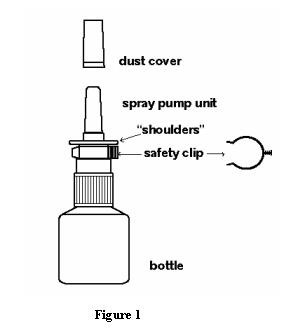
Before you use ASTEPRO Nasal Spray for the first time, you will need to prime the bottle.
To prime:
1. Remove the blue dust cover over the tip of the bottle and the blue safety clip just under the “shoulders” of the bottle. See Figure 2.
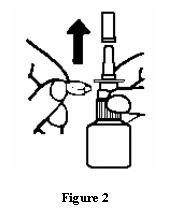
2. Hold the bottle upright with two fingers on the shoulders of the spray pump unit and put your thumb on the bottom of the bottle. Press upward with your thumb and release for the pumping action. Repeat this until you see a fine mist. This should happen in 6 sprays or less. See Figure 3.
Now your pump is primed and ready to use.
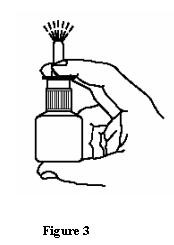
3. To get a fine mist you must pump the spray fast and use firm pressure against the bottom of the bottle. If you see a stream of liquid, the spray will not work right and may cause nasal discomfort.
4. If you do not use ASTEPRO Nasal Spray for 3 or more days, you will need to prime the pump with 2 sprays or until you see a fine mist. If you do not see a fine mist, clean the tip of the spray nozzle. See the cleaning section below.
To Use ASTEPRO Nasal Spray:
1. Gently blow your nose to clear nostrils.
2. Keep your head tilted downward toward your toes.
3. Place the spray tip ¼ to ½ inch into one nostril. Hold bottle upright and aim the spray tip toward the back of the nose. See Figure 4.
4. Close your other nostril with a finger. Press the pump one time and sniff gently at the same time, keeping your head tilted forward and down.
5. Repeat in other nostril.
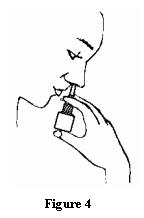
6. If your healthcare provider tells you to use 2 sprays in each nostril, repeat Steps 2 through 5 above for the second spray in each nostril.
7. Breathe in gently, and do not tilt your head back after using ASTEPRO Nasal Spray. This will help to keep the medicine from going into your throat.
8. When you finish using ASTEPRO Nasal Spray, wipe the spray tip with a clean tissue or cloth. Put the safety clip and dust cover back on the bottle.
To Clean the Spray Tip:
1. If the spray tip opening is clogged, do not use a pin or pointed object to unclog the tip. Unscrew the spray pump unit from the bottle by turning it counter-clockwise (to the left). See Figure 5.
2. Soak only the spray pump unit in warm water. Squirt several times while holding it under water. Use the pumping action to clear the opening in the tip. See Figure 6.
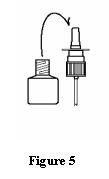
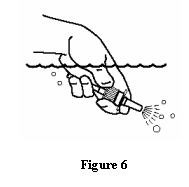
3. Let the spray pump unit air dry. Make sure it is dry before you put it back onto the bottle.
4. Put the spray pump unit back into the open bottle and tighten it by turning clockwise (to the right).
5. To keep the medicine from leaking out, use firm pressure when you put the pump back onto the bottle.
6. After cleaning, follow the instructions for priming.
Manufactured by:
MEDA Pharmaceuticals
Meda Pharmaceuticals Inc.
Somerset, NJ 08873-4120
©2009 Meda Pharmaceuticals Inc.
ASTEPRO and MEDA Pharmaceuticals are registered trademarks of Meda Pharmaceuticals Inc.
U.S. Patent Pending
IN-023D6-04 Revised 9/09
Package Label - Principal Display Panel – 4 mL Bottle, Astepro Nasal Spray 0.1%
NDC 0037-0242-57
4 mL
PROFESSIONAL SAMPLE: Not for Sale
Astepro® 0.1%
(azelastine HCl)
Nasal Spray
137 mcg per spray
22 Metered Sprays
FOR INTRANASAL USE ONLY
DO NOT SPRAY IN EYES Rx Only
Each spray delivers 0.137 mL
(137 mcg azelastine hydrochloride).
U.S. Patent Pending
LB-023D1-04 Rev. 9/09
IMPORTANT: READ ACCOMPANYING
DIRECTIONS CAREFULLY BEFORE USE.
Usual Dosage: See accompanying full
Prescribing Information. Initial priming:
6 sprays; Repriming: 2 sprays or until
a fine mist appears.
Also contains sorbitol, sucralose,
hypromellose, sodium citrate, edetate
disodium, benzalkonium chloride, and
purified water (pH 6.4).
Store upright at controlled room
temperature 20°-25°C (68°-77°F).
Protect from freezing.
Keep bottle upright, tightly closed,
and away from children.
Manufactured by
MEDA
Pharmaceuticals®
Meda Pharmaceuticals Inc.
Somerset, New Jersey 08873-4120
©2009 Meda Pharmaceuticals Inc.

Package Label - Principal Display Panel – 4 mL Carton, Astepro Nasal Spray 0.1%
NDC 0037-0242-57
4 mL
Astepro® 0.1%
(azelastine HCl)
Nasal Spray
137 mcg per spray
PROFESSIONAL SAMPLE: Not for Sale
FOR INTRANASAL USE ONLY
DO NOT SPRAY IN EYES
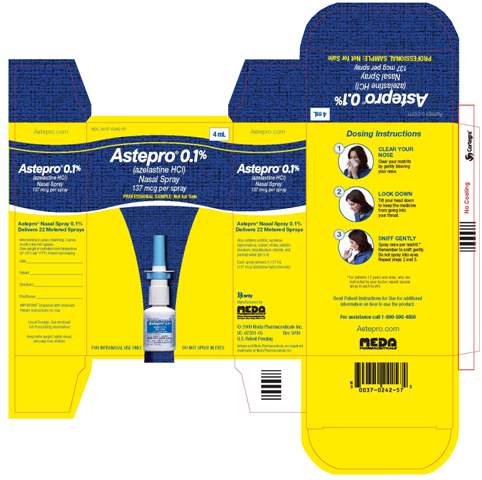
Package Label - Principal Display Panel – 30 mL Bottle, Astepro Nasal Spray 0.1%
NDC 0037-0242-30
30 mL
Astepro® 0.1%
(azelastine HCl)
Nasal Spray
137 mcg per spray
200 Metered Sprays
FOR INTRANASAL USE ONLY
DO NOT SPRAY IN EYES Rx Only
Each spray delivers 0.137 mL
(137 mcg azelastine hydrochloride).
U.S. Patent Pending
LB-023D6-04 Rev. 9/09
IMPORTANT: READ ACCOMPANYING
DIRECTIONS CAREFULLY BEFORE USE.
Usual Dosage: See accompanying full
Prescribing Information.
Initial priming: 6 sprays;
Repriming: 2 sprays or until
a fine mist appears.
Also contains sorbitol, sucralose,
hypromellose, sodium citrate, edetate
disodium, benzalkonium chloride, and
purified water (pH 6.4).
Store upright at controlled room
temperature 20°-25°C (68°-77°F).
Protect from freezing.
Keep bottle upright, tightly closed,
and away from children.
Manufactured by
MEDA
Pharmaceuticals®
Meda Pharmaceuticals Inc.
Somerset, New Jersey 08873-4120
©2009 Meda Pharmaceuticals Inc.

Package Label - Principal Display Panel – 30 mL Carton, Astepro Nasal Spray 0.1%
NDC 0037-0242-30
30 mL
Astepro® 0.1%
(azelastine HCl)
Nasal Spray
137 mcg per spray
FOR INTRANASAL USE ONLY
DO NOT SPRAY IN EYES
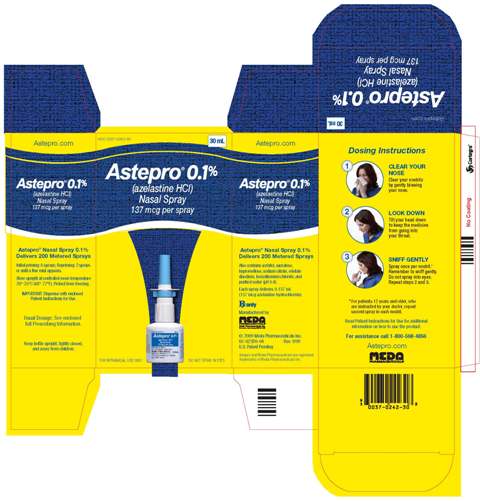
Package Label - Principal Display Panel – 4 mL Bottle, Astepro Nasal Spray 0.15%
NDC 0037-0243-04
4 mL
PROFESSIONAL SAMPLE: Not for Sale
Astepro® 0.15%
(azelastine HCl)
Nasal Spray
205.5 mcg per spray
22 Metered Sprays
FOR INTRANASAL USE ONLY
DO NOT SPRAY IN EYES Rx Only
Each spray delivers 0.137 mL
(205.5 mcg azelastine hydrochloride).
U.S. Patent Pending
LB-023E1-02 Rev. 9/09
IMPORTANT: READ ACCOMPANYING
DIRECTIONS CAREFULLY BEFORE USE.
Usual Dosage: See accompanying full
Prescribing Information. Initial priming:
6 sprays; Repriming: 2 sprays or until
a fine mist appears.
Also contains sorbitol, sucralose,
hypromellose, sodium citrate, edetate
disodium, benzalkonium chloride, and
purified water (pH 6.4).
Store upright at controlled room
temperature 20°-25°C (68°-77°F).
Protect from freezing.
Keep bottle upright, tightly closed,
and away from children.
Manufactured by
MEDA
Pharmaceuticals®
Meda Pharmaceuticals Inc.
Somerset, New Jersey 08873-4120
©2009 Meda Pharmaceuticals Inc.
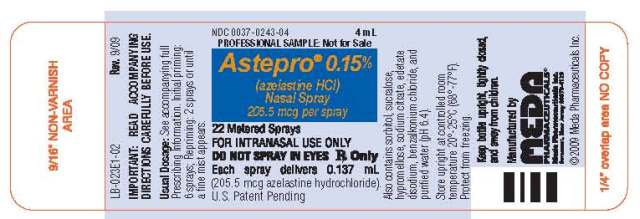
Package Label - Principal Display Panel – 4 mL Carton, Astepro Nasal Spray 0.15%
NDC 0037-0243-04
4 mL
NEW STRENGTH
Astepro® 0.15%
(azelastine HCl)
Nasal Spray
205.5 mcg per spray
PROFESSIONAL SAMPLE: Not for Sale
FOR INTRANASAL USE ONLY
DO NOT SPRAY IN EYES

Package Label - Principal Display Panel – 30 mL Bottle, Astepro Nasal Spray 0.15%
NDC 0037-0243-30
30 mL
Astepro® 0.15%
(azelastine HCl)
Nasal Spray
205.5 mcg per spray
200 Metered Sprays
FOR INTRANASAL USE ONLY
DO NOT SPRAY IN EYES Rx Only
Each spray delivers 0.137 mL
(205.5 mcg azelastine hydrochloride).
U.S. Patent Pending
LB-023E6-02 Rev. 9/09
IMPORTANT: READ ACCOMPANYING
DIRECTIONS CAREFULLY BEFORE USE.
Usual Dosage: See accompanying full
Prescribing Information.
Initial priming: 6 sprays;
Repriming: 2 sprays or until
a fine mist appears.
Also contains sorbitol, sucralose,
hypromellose, sodium citrate, edetate
disodium, benzalkonium chloride, and
purified water (pH 6.4).
Store upright at controlled room
temperature 20°-25°C (68°-77°F).
Protect from freezing.
Keep bottle upright, tightly closed,
and away from children.
Manufactured by
MEDA
Pharmaceuticals®
Meda Pharmaceuticals Inc.
Somerset, New Jersey 08873-4120
©2009 Meda Pharmaceuticals Inc.

Package Label - Principal Display Panel – 30 mL Carton, Astepro Nasal Spray 0.15%
NDC 0037-0243-30
30 mL
NEW STRENGTH
Astepro® 0.15%
(azelastine HCl)
Nasal Spray
205.5 mcg per spray
FOR INTRANASAL USE ONLY
DO NOT SPRAY IN EYES
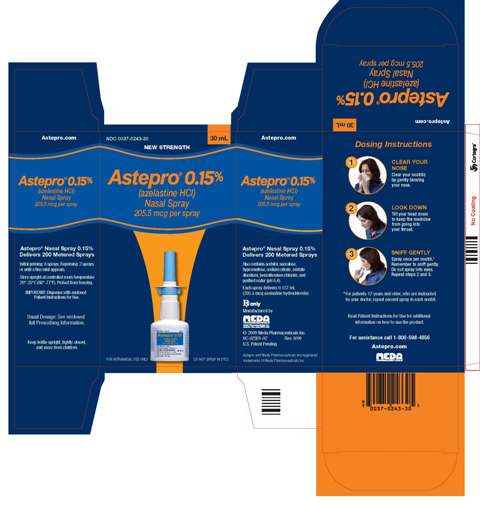
| ASTEPRO
azelastine hydrochloride spray, metered |
|||||||||||||||||||||||||
|
|||||||||||||||||||||||||
|
|||||||||||||||||||||||||
|
|||||||||||||||||||||||||
|
|||||||||||||||||||||||||
|
|||||||||||||||||||||||||
| Marketing Information | |||
| Marketing Category | Application Number or Monograph Citation | Marketing Start Date | Marketing End Date |
| NDA | NDA022203 | 11/20/2008 | |
| ASTEPRO
azelastine hydrochloride spray, metered |
|||||||||||||||||||||||||
|
|||||||||||||||||||||||||
|
|||||||||||||||||||||||||
|
|||||||||||||||||||||||||
|
|||||||||||||||||||||||||
|
|||||||||||||||||||||||||
| Marketing Information | |||
| Marketing Category | Application Number or Monograph Citation | Marketing Start Date | Marketing End Date |
| NDA | NDA022371 | 10/12/2009 | |
| Labeler - Meda Pharmaceuticals Inc. (051229602) |